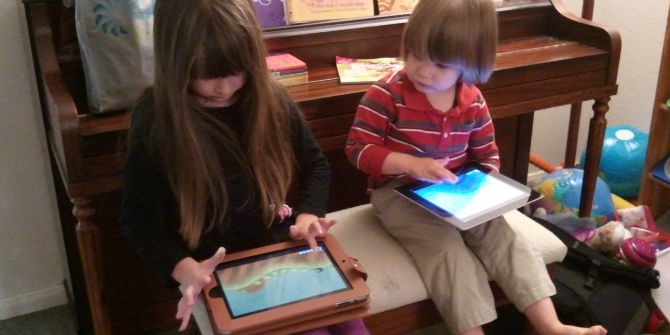 The UK’s Commission on Fake News and the Teaching of Critical Literacy Skills recently published a report on fake news and critical literacy which surveyed schoolchildren and teachers. LSE PhD researcher Gianfranco Polizzi summarises the key findings of the report – which include that only 2% of children can spot fake news – and sets out his recommendations in response. [Header image credit: Y.C.V. Chow, CC BY-NC 2.0_2]
The UK’s Commission on Fake News and the Teaching of Critical Literacy Skills recently published a report on fake news and critical literacy which surveyed schoolchildren and teachers. LSE PhD researcher Gianfranco Polizzi summarises the key findings of the report – which include that only 2% of children can spot fake news – and sets out his recommendations in response. [Header image credit: Y.C.V. Chow, CC BY-NC 2.0_2]
If on the one hand it is difficult to define fake news – as to whether it implies, for instance, false information that is deliberate or not – on the other hand, this term is commonly understood as synonymous with misinformation. In an age which is highly mediated by digital technologies, the rate at which misinformation can spread is unprecedented. As a result, there are growing concerns about the implications of misinformation. Most problematically, the condition upon which our democracies rely – a citizenry making informed decisions – is undermined.
After conducting research and gathering evidence from experts, the Commission on Fake News and the Teaching of Critical Literacy Skills (run by the All-Party Parliamentary Group on Literacy, the National Literacy Trust and other partners) has recently published a report on children’s media use, fake news and the teaching of critical literacy in schools in the United Kingdom. Critical literacy is often understood as the ability to evaluate information by questioning its trustworthiness, which is how it was approached empirically by the Commission. As acknowledged in their report, however, critical literacy in the digital age should also entail awareness of how and why information is created, disseminated and consumed in the digital environment. Given the internet’s potential to facilitate, for instance, both freedom of expression and data surveillance, critical digital literacy can also be approached as incorporating reflexivity about “the internet’s […] democratising potential and its structural constraints”.
New findings
The Commission surveyed 388 primary school students, 1832 secondary school students and 414 teachers in the UK, ran focus groups with students and teachers, and took various other forms of evidence. The Commission concluded that:
- only 2% of children have the critical literacy skills to discern truth from fake news.
- roughly 60% of students (3 in 5 children) who had heard of fake news said it made them trust the news less.
- while primary and secondary students mostly access and trust the news on TV and radio, nearly half of older children access the news online (43.8% from websites and 49.5% from Snapchat). A quarter of children trust websites and social media.
- half of children are worried about whether they can identify fake news.
- only 6% of students (4.8% of primary students and 7.9% of secondary students) speak to teachers about fake news.
As for teachers:
- 61% are concerned about fake news affecting children’s well-being. The focus groups revealed that teachers are worried about fake news creating anxiety among students.
- half (54%) think the national curriculum does not equip students well enough to spot fake news.
- 35% think critical literacy is taught in ways that are not transferable to the outside world.
New questions
While these findings emphasise how urgently children need to acquire critical literacy skills in the digital age, they do not imply that the fake news phenomenon is exclusively related to children, nor that critical literacy is the only solution. The Commission has acknowledged in its report that adults also need critical literacy. Although the education system plays a crucial role in promoting critical literacy, it cannot reach adults. On the other hand, the family is a key way to reach children.
Additionally, the media industry has a role to play. During the launch of the report, Facebook was described as 1) tweaking its algorithms to spot and remove misinformation; and 2) designing tools enabling users to judge content credibility. For instance, the giant corporation is adding a button to news articles, one that allows users to access background information on publishers. However meritorious, whether these measures are sufficient remains to be seen.
Alarmingly, the findings of the Commission resonate with Ofcom’s 2017 conclusion that one out of four children in Britain believe that a website can be trusted if listed by a search engine. While they potentially fuel public anxiety, we should ask first, and find answers to, a few questions:
- While only 2% of children can spot fake news, what is the percentage of teachers who can identify misinformation?
- To what extent do roughly 60% of children trust the news less because of having heard of fake news? In Western societies, citizens’ trust is often undermined by alienation from politics, institutions and the media. Is children’s (dis)trust a reflection of parents’ (dis)trust expressed within family settings? Research suggests that attitudes towards trust tend to be transmitted from parents to children.
- 61% of teachers are worried that the fake news phenomenon is affecting children’s well-being, but is that really so or is that what teachers think? There is a risk of encouraging an overly protectionist approach to children’s internet use, one that minimises their online risks as well as opportunities for learning and socialising. Research shows that with more online risks come inevitably more opportunities and vice versa.
- While half of teachers think the national curriculum needs to be revised, the question is how critical literacy should be taught through a revised national curriculum. Do we need a more student-centred approach to teaching, one that privileges critical thinking over a teacher-centred approach based on knowledge transmission? If we do, a revised curriculum is not enough, as it is also a matter of pedagogy, teaching style and assessment formats. Relatedly, is critical thinking enough? And should this be encouraged across different disciplines? As information is highly digitally mediated, we need to teach students about the broader digital environment. However, the computing curriculum is overly focused on practical skills. As an optional subject, media studies – which has the potential to teach students such skills – is “taken by only a handful of students”.
- Only 6% of students speak to teachers about fake news, while 35% of teachers think critical literacy is not taught in schools in ways that are transferable to the real world. Aren’t librarians those who can best fill these gaps? Wouldn’t it be better for students to know that they can discuss fake news with information experts, considering that teachers might lack that expertise? If so, it is problematic that libraries are in decline in the UK, because of decreasing staffing and budgets, with thousands “actually or virtually unused”. Furthermore, “there is no statutory requirement for schools in England to have a school library”.
Recommendations
What stands out from brainstorming new questions in response to this report is that:
- A more comprehensive approach to critical literacy is needed when both researching and teaching it. In the digital age, critical literacy needs to entail awareness of the broader digital environment.
- To boost critical literacy, the national curriculum needs to be revised. Media studies should be promoted more robustly, while computing should be not only about practical skills but also critical reflexivity about the digital landscape. In parallel, we need a more student-centred approach encouraging critical thinking over knowledge transmission.
- Libraries inside and outside schools need to be incentivised to support librarians as information advisers.
We also need:
- to avoid translating alarming findings into a protectionist approach that minimises children’s exposure to both online risks and opportunities.
- more research into teachers’ ability to identify misinformation, keeping in mind that critical literacy goes beyond children.
- to reflect on whether the steps being taken by social media companies against misinformation are sufficient.
- to reflect on children’s distrust in the news as potentially stemming from family settings and adults’ distrust in politics, institutions and the media.
We should not be discouraged if providing answers leads to new questions. It is only by doing so that we can better understand how to tackle fake news and promote critical literacy.
Notes
This text was originally published on the Media Policy Project blog and has been re-posted with permission.
This article gives the views of the author and does not represent the position of the LSE Parenting for a Digital Future blog, nor of the London School of Economics and Political Science.





